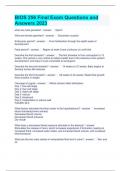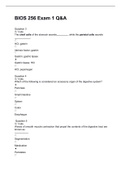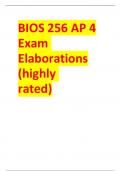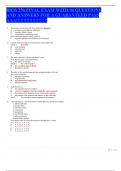Bios 256 digestive system Study guides, Class notes & Summaries
Looking for the best study guides, study notes and summaries about Bios 256 digestive system? On this page you'll find 68 study documents about Bios 256 digestive system.
Page 3 out of 68 results
Sort by
BIOS 256| EDAPT STRUCTURES AND FUNCTIONS OF THE DIGESTIVE SYSTEM QUIZ WITH ANSWERS| 2024

-
BIOS 256| EDAPT HORMONAL AND NEURAL REGULATION OF DIGESTIVE PROCESSES QUIZ WITH 100% CORRECT ANSWERS| 2024
- Exam (elaborations) • 3 pages • 2024
-
- $12.49
- + learn more
BIOS 256| EDAPT HORMONAL AND NEURAL REGULATION OF DIGESTIVE PROCESSES QUIZ WITH 100% CORRECT ANSWERS| 2024 Anatomy and Physiology IV with Lab-Flanagan > Unit 2 Which of the following is inhibited by the sympathetic nervous system? (Select all that apply.) Which of the following might stimulate the cephalic phase of gastric secretion? Small intestine distension The production and secretion of gastrin The thought of food Stomach distension The production of saliva Defecation Diges...

-
BIOS 256 Exam 1 Q&A.
- Exam (elaborations) • 13 pages • 2023
-
- $14.99
- + learn more
BIOS 256 Exam 1 Q&A.Question 3 3 / 3 pts The chief cells of the stomach secrete , while the parietal cells secrete . HCl; gastrin Intrinsic factor; gastrin Gastrin; gastric lipase Gastric lipase; HCl HCl; pepsinogen Question 4 3 / 3 pts Which of the following is considered an accessory organ of the digestive system? Pancreas Small intestine Spleen Colon Esophagus Question 5 3 / 3 pts Waves of smooth muscle contraction that propel the contents of the digestive tract ar...

-
BIOS 256| EDAPT STRUCTURES AND FUNCTIONS OF THE DIGESTIVE SYSTEM QUIZ WITH ANSWERS| 2024
- Exam (elaborations) • 3 pages • 2024
- Available in package deal
-
- $11.49
- + learn more
BIOS 256| EDAPT STRUCTURES AND FUNCTIONS OF THE DIGESTIVE SYSTEM QUIZ WITH ANSWERS| 2024

-
BIOS 256| EDAPT STRUCTURES AND FUNCTIONS OF THE DIGESTIVE SYSTEM QUIZ WITH ANSWERS| 2024
- Exam (elaborations) • 3 pages • 2024
- Available in package deal
-
- $11.49
- + learn more
BIOS 256| EDAPT STRUCTURES AND FUNCTIONS OF THE DIGESTIVE SYSTEM QUIZ WITH ANSWERS| 2024

-
BIOS 256 Final Exam Questions and Answers 2023
- Exam (elaborations) • 8 pages • 2023
- Available in package deal
-
- $17.99
- + learn more
BIOS 256 Final Exam Questions and Answers 2023 what are male gametes? Sperm What are female gametes? Secondary oocytes Embryonic period? From fertilization through the eighth week of development Fetal period? Begins at week 9 and continues on until birth Describe the first trimester? The first trimester is from conception to 13 weeks. This period is very critical to babies health due to the extensive oran-system development, and baby is most vulnerable to terato...

-
BIOS 256 Exam 1 Q&A.
- Exam (elaborations) • 13 pages • 2023
-
- $14.99
- + learn more
BIOS 256 Exam 1 Q&A.Question 3 3 / 3 pts The chief cells of the stomach secrete , while the parietal cells secrete . HCl; gastrin Intrinsic factor; gastrin Gastrin; gastric lipase Gastric lipase; HCl HCl; pepsinogen Question 4 3 / 3 pts Which of the following is considered an accessory organ of the digestive system? Pancreas Small intestine Spleen Colon Esophagus Question 5 3 / 3 pts Waves of smooth muscle contraction that propel the contents of the digestive tract ar...

-
BIOS 256 FINAL EXAM STUDY Q&A | Comprehensive ATI graded A+
- Exam (elaborations) • 29 pages • 2023
-
- $17.99
- + learn more
BIOS 256 FINAL EXAM STUDY Q&A | Comprehensive ATI 1 The urinary system does all of the following, EXCEPT it A secretes excess glucose molecules B regulates blood volume C contributes to stabilizing blood pH D eliminates organic waste products E regulates plasma concentrations of electrolytes 2 Conical structures that are located in the renal medulla are called A pyramids B renal columns C renal pelvises D nephrons E calyces 3 The region known as the macula densa is part of...

-
BIOS 256 AP 4 Exam Elaborations (highly rated)
- Exam (elaborations) • 35 pages • 2023
-
- $10.89
- + learn more
Week 2: Chapter 24: The Digestive System part two Basic GI Functions Primary function: movement of nutrient molecules from the external environment to the internal environment. (Absorption of nutrients) Food->Digestion->motility and absorption Pancreas Gland in the retroperitoneal space behind the stomach Produces enzymesthat digest carbs, proteins, fats, and nucleic acids Produces the sodium bicarbonate buffer Emptiesthe contents into duodenum Relationship of the Pancreas to th...

-
BIOS 256 FINAL EXAM WITH 94 QUESTIONS AND ANSWERS FOR A GUARANTEED PASS AAA
- Exam (elaborations) • 19 pages • 2023
-
- $13.99
- + learn more
1 The urinary system does all of the following, EXCEPT it A secretes excess glucose molecules B regulates blood volume C contributes to stabilizing blood pH D eliminates organic waste products E regulates plasma concentrations of electrolytes 2 Conical structures that are located in the renal medulla are called A pyramids B renal columns C renal pelvises D nephrons E calyces 3 The region known as the macula densa is part of A the proximal convoluted tubule B the distal convoluted t...

How much did you already spend on Stuvia? Imagine there are plenty more of you out there paying for study notes, but this time YOU are the seller. Ka-ching! Discover all about earning on Stuvia



